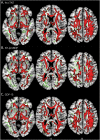Associations of Blood Cardiovascular Biomarkers With Brain Free Water and Its Relationship to Cognitive Decline: A Diffusion-MRI Study
- PMID: 37202157
- PMCID: PMC10351542
- DOI: 10.1212/WNL.0000000000207401
Associations of Blood Cardiovascular Biomarkers With Brain Free Water and Its Relationship to Cognitive Decline: A Diffusion-MRI Study
Abstract
Background and objectives: There is an increasing awareness of the "Heart-Brain Connection," whereby cardiovascular function is connected with cognition. Diffusion-MRI studies reported higher brain free water (FW) was associated with cerebrovascular disease (CeVD) and cognitive impairment. In this study, we investigated whether higher brain FW was related to blood cardiovascular biomarkers and whether FW mediated the associations between blood biomarkers and cognition.
Methods: Participants recruited from 2 Singapore memory clinics between 2010 and 2015 underwent collection of blood samples and neuroimaging at baseline and longitudinal neuropsychological assessments up to 5 years. We examined the associations of blood cardiovascular biomarkers (high-sensitivity cardiac troponin-T [hs-cTnT], N-terminal pro-hormone B-type natriuretic peptide [NT-proBNP], and growth/differentiation factor 15 [GDF-15]) with brain white matter (WM) and cortical gray matter (GM) FW derived from diffusion MRI using whole brain voxel-wise general linear regression. We then assessed the relationships among baseline blood biomarkers, brain FW, and cognitive decline using path models.
Results: A total of 308 older adults (76 with no cognitive impairment, 134 with cognitive impairment no dementia, and 98 with Alzheimer disease dementia and vascular dementia; mean [SD] age: 72.1 [8.3]) were included. We found that blood cardiovascular biomarkers were associated with higher FW in widespread WM regions and in specific GM networks including the default mode, executive control, and somatomotor networks at baseline (p < 0.01, family-wise error corrected). Baseline FW in widespread WM and network-specific GM fully mediated the associations of blood biomarkers with longitudinal cognitive decline over 5 years. Specifically, in GM, higher FW in the default mode network mediated the relationship with memory decline (hs-cTnT: β = -0.115, SE = 0.034, p = 0.001; NT-proBNP: β = -0.154, SE = 0.046, p = 0.001; GDF-15: β = -0.073, SE = 0.027, p = 0.006); by contrast, higher FW in the executive control network was responsible for executive function decline (hs-cTnT: β = -0.126, SE = 0.039, p = 0.001; NT-proBNP: β = -0.110, SE = 0.038, p = 0.004; GDF-15: β = -0.117, SE = 0.035, p = 0.001). Similar full mediation effects of brain FW were also identified for baseline cognition.
Discussion: Results suggested a role of brain FW in linking cardiovascular dysfunction to cognitive decline. These findings provide new evidence for brain-heart interactions, paving the way for prediction and monitoring of domain-specific cognitive trajectory.
Copyright © 2023 The Author(s). Published by Wolters Kluwer Health, Inc. on behalf of the American Academy of Neurology.
Conflict of interest statement
A.M. Richards reports fees, grants, honoraria, and aid in kind for Roche Diagnostics and Abbott Laboratories. The rest of the authors report no disclosures relevant to the manuscript. Go to
Figures





Comment in
-
Getting to the Heart of the Heart-Brain Connection: Association or Causation?Neurology. 2023 Jul 11;101(2):57-58. doi: 10.1212/WNL.0000000000207520. Epub 2023 May 18. Neurology. 2023. PMID: 37202162 No abstract available.
References
Publication types
MeSH terms
Substances
LinkOut - more resources
Full Text Sources
Medical
Research Materials
